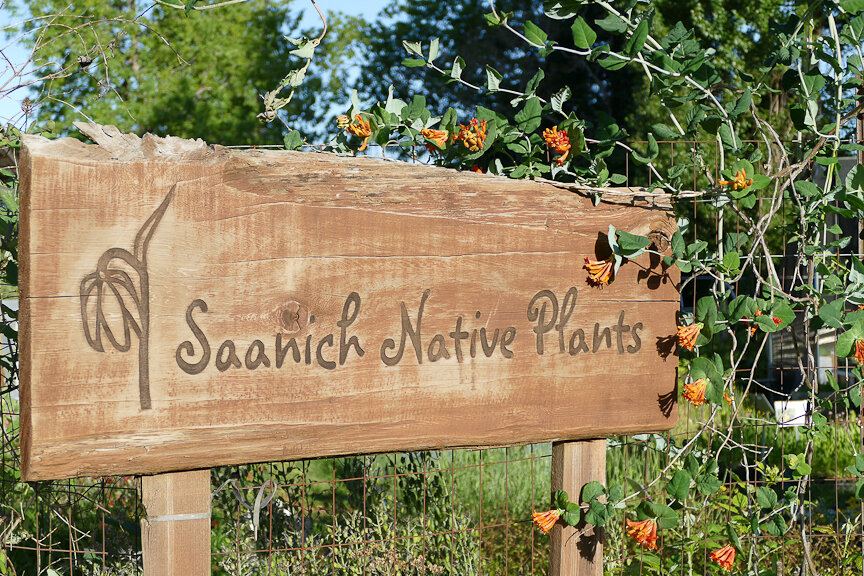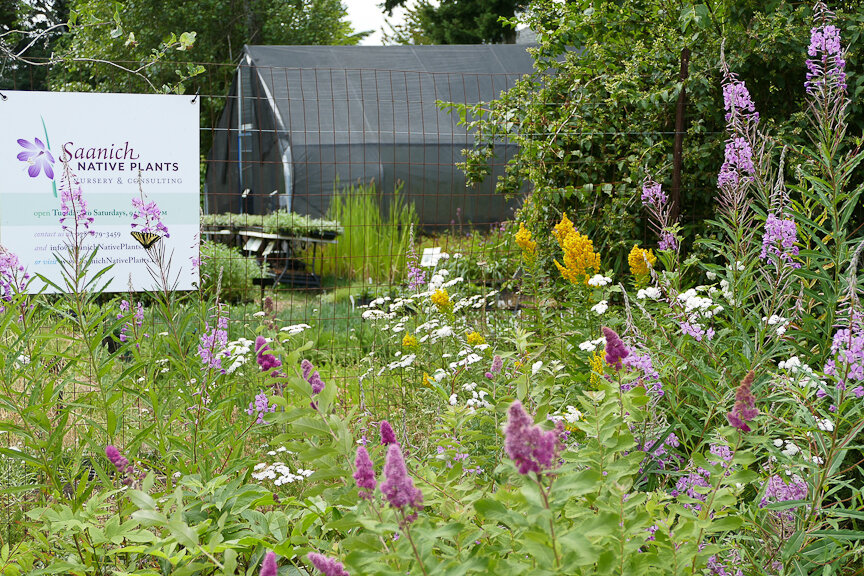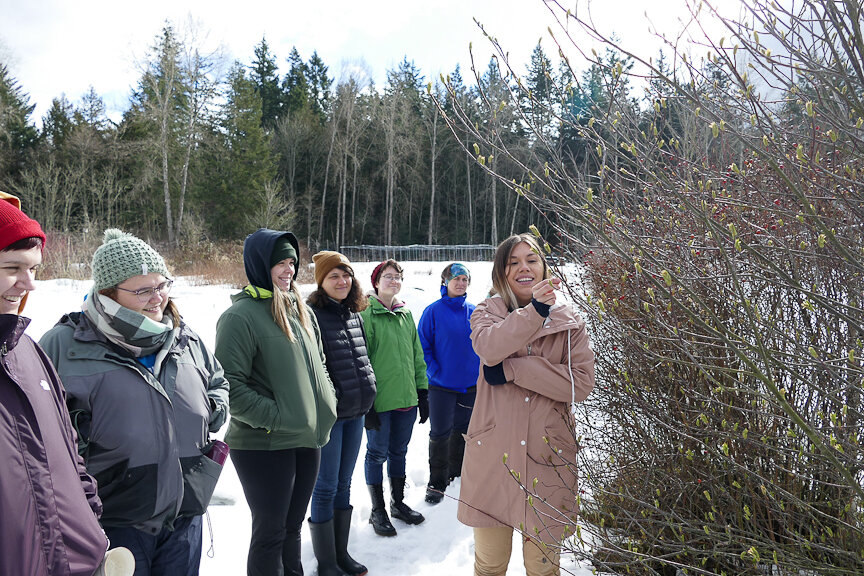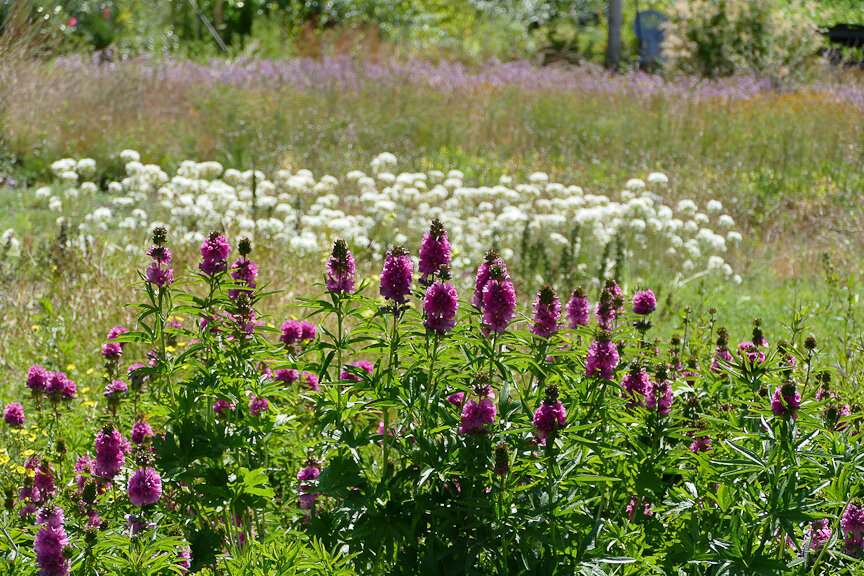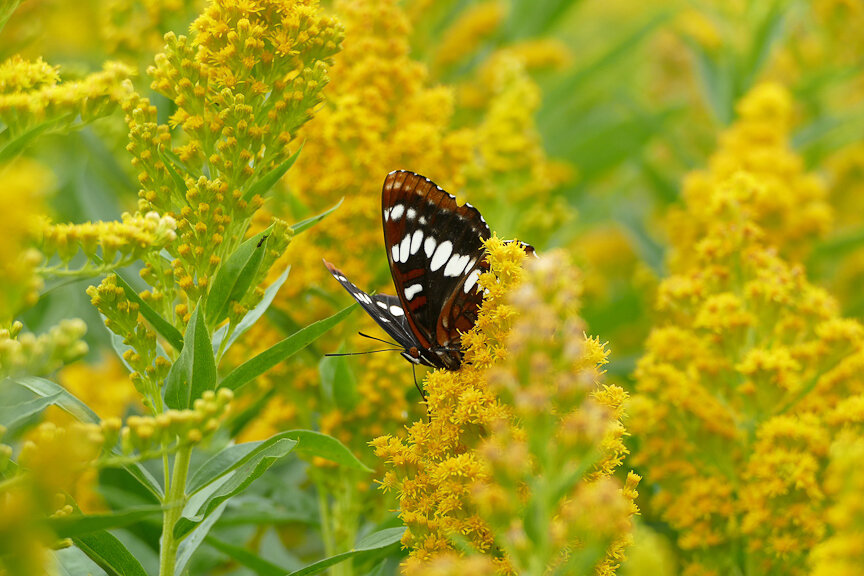Native Plants find a home on Vancouver Island
Satinflower Nurseries Native Plants working to rewild Canada’s gardening paradise
Kristen Miskelly has travelled a long way to find her new home near Victoria B.C.
In fact, it would be harder to find a location in Canada much farther from her Toronto-area roots than her current home on the Saanich Peninsula northeast of Victoria, British Columbia.
But there’s no doubt in her mind that Vancouver Island – undoubtedly one of the finest area in Canada to garden – is her new home.
It’s also the home of Satinflower Nurseries Native Plants, seeds & Consulting (formerly Saanich Native Plants), the business Kristen and her husband, James, have grown from a seed of an idea into a highly successful native plant nursery and consulting firm.
Satinflower Nurseries Native Plants, seeds & Consulting offers a robust retail side to their business, but much of the nursery’s work involves consulting and installation of much larger properties in and around the Victoria area ranging from private lands restoration to commercial and government. The native plant nursery is helping to rewild the land around Victoria B.C.
(For more information on West Coast native plants and garden design, be sure to check out my comprehensive post on Seattle landscape designer Alexa LeBouef Brooks. Also, Check out Alexa’s Pacific Northwest front garden design plan complete with plant list.)
Also, if you are interested in native plants, be sure to check out my post on Gardening with Native Plants of the Pacific Northwest.
Satinflower Nurseries Native Plants (formerly Saanich Native Plants) is an excellent source of native wildflowers, shrubs and trees for westerly residents especially in the Victoria-area.
For my article on the the importance of using native plants in our garden, go here.
“I absolutely love the Victoria area,” she says. “It’s an absolutely beautiful place.”
It’s not surprising that Kristen, who was born in Welland Ontario but from grade 4 to 12 lived in Aurora just north of Toronto, is in love with the stunningly beautiful landscapes and moderate weather that makes Vancouver Island such a special place. The Saanich Peninsula, once a farming region, is surrounded by water on all sides and continues to feature pastures and an abundance of rolling hills. It’s hard to imagine a more perfect place for a couple with a great love for gardening and native plants.
“We’ve built our business on the core principle of valuing nature. We try to continually work with integrity and excellence and value collaboration greatly.”
It’s the ideal canvas to begin the work of rewilding with native plants, with the goal of helping to bring back much of the rich variety of plants, trees, insects and animals to the area.
Their work has not gone unnoticed. In fact, Satinflower Nurseries Native Plants, seeds & Consulting (Saanich Native Plants) was the recipient of the area’s 2016 environmental award in business achievement.
“I love growing indigenous plants and there is no part of the year we can’t work on them here at our nursery,” she explains on a cold, snowy, mid-February day in Ontario. “We are just planting up some grasses here today.” she adds.
Kristen knew she was home when she left Ontario to begin her studies at the University of Victoria, where she completed both her undergraduate work and a Master of Science in Biology. Her undergraduate work focused on grass taxonomy and her Masters research used palynology – the study of pollen grains – to learn more about the ancient vegetation of southern Vancouver Island.
Her husband, James, has similar expertise. The co-founder of Satinflower Nurseries Native Plants is a biologist with expertise in Garry Oak ecosystems, plants, insects, and restoration. He has a Master of Science in Biology, also from the University of Victoria.
So, it’s no surprise that upon graduation the couple went to work establishing the roots of what soon would become their prosperous native plant business.
“James and I made a decision that when I finished my Masters degree we would begin working more intensively with native plants.” Afterall, she admits, they “were both obsessed with native plants.”
• If you are considering creating a meadow in your front or backyard, be sure to check out The Making of a Meadow post for a landscape designer’s take on making a meadow in her own front yard.
Meadow plants put on a show at one of the Nursery’s locations.
Their nursery took root in 2013 at Haliburton Community Organic Farm, where they had been working as volunteers to coordinate the restoration of a native meadow and wetland. They used a small front lawn of the farm house as their retail outlet for what would become the Saanich Native Plants Nursery & Consulting business (now known as Satinflower Nurseries Native Plants and seeds.) In 2015, they leased an additional half acre at Haliburton Farm for plant propagation and native seed production and in 2018 expanded their native seed fields further to Fairfield Farm just outside of the Victoria core. Kristen emphasizes how grateful both her and James are for the opportunities that the non-profit Society who runs the farm has provided to them and the broader community.
Growing popularity of native plants
From those simple roots rose a successful small business that now employs up to 10 employees over the course of the year and features more than 200 native plants, a large, ever-growing native seed catalogue, several planting fields and soon, a new home for the growing business.
The couple have recently purchased a property in Metchosin near Victoria and plan to use it as a base for their growing business. The new 2-acre property will be staged as growing fields for both plants and seed production. The nursery grows most of its own plants from seed and offers a large selection of seeds at both the commercial and retail level.
Although Satinflower Nurseries Native Plants offers a robust retail side to their business, much of the work involves consulting and installation of much larger properties in and around the Victoria area ranging from private lands restoration to commercial and government.
The new, larger location may be illustrative of the growing popularity of native plants not just on Vancouver Island but across Canada, the United States and Europe.
Kristen says it’s difficult to tell if the expansion of Satinflower Nurseries Native Plants and Seeds is a natural progression of the business or the result of a surge in the interest of using native plants in the gardens of both homeowners and in large scale commercial settings and government projects. But, she is quick to add that with the emergence of social media groups such as Facebook, native plant groups and on-line discussion groups represent “a change in education outreach in society.”
“There is a genuine interest in restoration and conserving nature,” Kristen explains. People are seeing “more habitat destruction every day and they are trying to find something proactive to do to counter that devastation.”
“Sometimes,” she adds, “just planting a few native wildflowers in your garden exposes you to the joys and benefits of using native plants and from there, the enthusiasm just grows.”
Satinflower Nurseries Native Plants and Seeds is certainly playing a role in conserving nature and helping to educate gardeners in their area about the importance of using native plants.
Besides teaching a range of courses and workshops related to plant identification, botany, restoration, and propagation, Kristen currently teaches Ecosystem Design through Propagation of Native Plants and Urban Restoration and Sustainable Agricultural Systems at the University of Victoria.
Their website states that the company’s aim is to inspire and empower people to restore and conserve nature by providing native plants, seeds, education, and expertise.
Education and outreach make up the foundation of the nursery. Here Beangka Elliot, Tsartlip First Nation, co-hosts one of the nursery’s regular educational workshops.
Expertise at the root of Nursery’s success
When it comes to expertise, it would be difficult to find a more knowledgeable staff than the folks at Saanich Native Plants. You already know about Kristen’s expertise, her husband, James, has his own expertise in Garry Oak ecosystems. His Master of Science focused on butterflies and their habitat needs. Besides his work in various capacities in rare plants and animals, he is a research associate at the Royal BC Museum in entomology with a focus on Canadian Orthoptera (crickets, grasshoppers and katydids.) For his day job, James works with Natural Resources Canada, where he helps to conserve and restore habitats and rare species of Federal Department of National Defence (DND) lands.
At the nursery, James plays a role in the consulting aspects of the nursery that often works on larger government projects. In addition, he manages the native seed fields and develops specialized seed mixes for nursery customers.
But that really is just the beginning of the expertise the nursery offers customers. Julia Daly, with a BSc in Geography from the University of Victoria and a diploma in Applied Coastal Ecology from Northwest Community College, puts her knowledge of plant identification, species-at-risk management, ecological restoration, and native plant gardening to work at the nursery.
Andrea Simmonds brings new perspectives to native plant garden installations with her artistic background and her patient and kind demeanor is always welcome when working with a range of clientele.
Josh Aitken brings extensive experience from working on farms growing up in rural Australia and Paige Erickson-McGee brings a passion for conservation and knowledge of native plants along with her BSc Geography from UVic and an Environmental Technologist diploma from a local College.
Sasha Kubicek brings an extensive knowledge of local orchids and protecting orchid habitats. He and his wife, Robin, oversee the seed saving part of Sea Bluff Farm – a 10 acre certified organic vegetable farm with a 600-foot section set aside as a native pollinator hedge row. They are also actively rehabilitating the farm’s Garry Oak grove.
Daniela Toriola-Lafuente moved to Victoria in 2012 from France after obtaining her BSc in natural sciences at the University of Lausanne and PhD in tropical forest ecology at the University of Paris. One of her passions is propagating native plants and taking great pleasure that her work is having a positive ecological impact.
Other consultants and partners bring a diversity of expertise and perspectives. Beangka Elliott from the Tsartlip First Nation of WSÁNEĆ (Saanich) Territory has a background in sharing traditional knowledges of Indigenous foods and medicines through workshop-based learning. Beangka started working at Saanich Native Plants in 2018 in propagation as well as providing workshops on a variety of topics. Beangka, no longer a regular employee, leads a suite of regular workshops at the nursery with a focus on consent-based practices and Indigenous foods and food systems.
Kristen points out that although many of the people who make up the nursery team have impressive credentials, nothing replaces a “passion for native plants. When we hire we are looking for that authentic passion – everything else can be learned.”
“Expertise is important when you are selling indigenous plants,” explains Kristen. Many of the plants are not well known to the general population so Kristen and her staff consider it vital to be able to pass on their knowledge on the care of the plants and educating clients to know what they are planting and how the plants will perform in various growing conditions.
She also emphasizes that land stewardship by Indigenous Peoples, past and present, continues to play a critical role in the awareness of the importance of native plants and natural areas in the Victoria area.
We’ve built our business on the core principle of valuing nature. We try to continually work with integrity and excellence and value collaboration greatly,” states the introduction on their website.
The nursery grows plants and produce seeds native to a variety of habitats in the Victoria area, including meadows, woodlands, forests, wetlands and beaches. The company also specializes in the restoration and ecology of Garry Oak ecosystems (Prairie-Oak ecosystems in Ontario and the southeast United States) and meadowscaping.
The native plant seed rows at Satinflower Nurseries Native Plants, seeds & Consulting provide a stunning visual display as well as habitat for wildlife.
Their commitment to the environment is evident in the fact that no herbicides or pesticides (including neonicotinoids) or chemical fertilizers are used in their business.
Although it would be easy to think that everything grows perfectly on Vancouver Island, that would be a false presumption. Kristen explains that annual precipitation across the Island varies greatly, ranging from rainforest on the westcoast to Mediterranean-like to the southeast
In Saanich, where the Nursery is located, it is in the “rainshadow of the Olympic Mountains resulting in extremely droughty summers,” explains Kristen. In fact, the location has the lowest average summer precipitation anywhere in Canada. “Even Vancouver gets two times the rainfall we do,” she explains. “Just a couple hours from where we are is rainforest.”
All this means that the native plants they grow are very focused to a specific geographical area. Kristen explains that their growing zone is part of a broader ecoregion that extends into Washington and Oregon.
Kristen and James love returning to Kristen’s roots in Ontario to experience the diverse range of flora and fauna of the Carolinian zone in Southern Ontario. She points out that her former home in Ontario is very biodiverse, having a wider variety of both flora and fauna than they enjoy on the Saanich Peninsula.
Bringing in the butterflies
Sometimes a single plant in a homeowners garden can inspire them to explore more native plants, explains Kristen. Every time we see wildlife using the native plants, it serves as endless inspiration to keep doing the work that we are doing.
The social activism and access to nature that many BC residents enjoy has resulted in an engagement with nature that she also hopes is being felt in Ontario as well. Kristen notes that “The gardeners, conservationists, and environmentalists in Ontario who have been working to educate others on the importance of native plants serve as inspiration for others”.
On an earlier visit to Ontario, the couple were particlarly impressed with the massive growing facilities at St. Williams Nursery & Ecology Centre in Norfolk County in the heart of southwestern Ontario’s Carolinian Life Zone. The largest native plant nursery in Ontario, stretches some 6 acres of greenhouses and more that 250 acres of production fields, is a wholesale conservation nursery and ecological restoration provider. Its team of restoration scientists and practitioners, nursery growers, and technical experts support and supply a variety of conservation initiatives across the province of Ontario.
Kristen and James have also spent time with Ontario Naturalists Mary Gartshore and Peter Carson who started Pterophylla in old South Walsingham. Peter and Mary worked to restore a 60-acre Tobacco farm back to black oak savanna and forest. Kristen notes that the “Pterophylla restoration project continues to be a tremendous example of what conservation impacts hands-on restoration by individuals can have”.
It’s always exciting to see how others operate their nurseries and get new ideas, she says. Places like St. Williams have greatly inspired us.
What’s the future hold for Satinflower Nurseries Native Plants, seeds & Consulting? The couple are busy preparing their new nursery location in Metchosin with everything from installing irrigation to re-planting their native seed fields. The Nursery is also re-doing their website in an effort to provide more online educational resources for the public. The new website will also feature a digital newsletter and online store to make native plants and seeds more easily available to everyone in their area. If you haven’t already, be sure to check out the impressive new Ontario Native Plants’ website.
Readers in Canada’s west who are looking for homegrown native plants need to check out Saanich Native Plants.
More links to my articles on native plants
Why picking native wildflowers is wrong
Serviceberry the perfect native tree for the garden
The Mayapple: Native plant worth exploring
Three spring native wildflowers for the garden
A western source for native plants
Native plants source in Ontario
The Eastern columbine native plant for spring
Three native understory trees for Carolinian zone gardeners
Ecological gardening and native plants
Eastern White Pine is for the birds
Native viburnums are ideal to attract birds
The Carolinian Zone in Canada and the United States
Dogwoods for the woodland wildlife garden
Bringing Nature Home by Douglas Tellamy
A little Love for the Black-Eyed Susan
Native moss in our gardens
As an affiliate marketer with Amazon or other marketing companies, I earn money from qualifying purchases.

